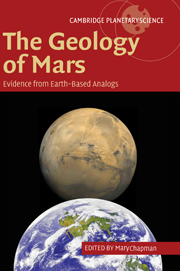Book contents
- Frontmatter
- Contents
- Preface: the rationale for planetary analog studies
- List of contributors
- 1 The geology of Mars: new insights and outstanding questions
- 2 Impact structures on Earth and Mars
- 3 Terrestrial analogs to the calderas of the Tharsis volcanoes on Mars
- 4 Volcanic features of New Mexico analogous to volcanic features on Mars
- 5 Comparison of flood lavas on Earth and Mars
- 6 Rootless volcanic cones in Iceland and on Mars
- 7 Mars interior layered deposits and terrestrial sub-ice volcanoes compared: observations and interpretations of similar geomorphic characteristics
- 8 Lava—sediment interactions on Mars: evidence and consequences
- 9 Eolian dunes and deposits in the western United States as analogs to wind-related features on Mars
- 10 Debris flows in Greenland and on Mars
- 11 Siberian rivers and Martian outflow channels: an analogy
- 12 Formation of valleys and cataclysmic flood channels on Earth and Mars
- 13 Playa environments on Earth: possible analogs for Mars
- 14 Signatures of habitats and life in Earth's high-altitude lakes: clues to Noachian aqueous environments on Mars
- 15 The Canyonlands model for planetary grabens: revised physical basis and implications
- 16 Geochemical analogs and Martian meteorites
- 17 Integrated analog mission design for planetary exploration with humans and robots
- Index
- Plate section
- References
10 - Debris flows in Greenland and on Mars
Published online by Cambridge University Press: 18 September 2009
- Frontmatter
- Contents
- Preface: the rationale for planetary analog studies
- List of contributors
- 1 The geology of Mars: new insights and outstanding questions
- 2 Impact structures on Earth and Mars
- 3 Terrestrial analogs to the calderas of the Tharsis volcanoes on Mars
- 4 Volcanic features of New Mexico analogous to volcanic features on Mars
- 5 Comparison of flood lavas on Earth and Mars
- 6 Rootless volcanic cones in Iceland and on Mars
- 7 Mars interior layered deposits and terrestrial sub-ice volcanoes compared: observations and interpretations of similar geomorphic characteristics
- 8 Lava—sediment interactions on Mars: evidence and consequences
- 9 Eolian dunes and deposits in the western United States as analogs to wind-related features on Mars
- 10 Debris flows in Greenland and on Mars
- 11 Siberian rivers and Martian outflow channels: an analogy
- 12 Formation of valleys and cataclysmic flood channels on Earth and Mars
- 13 Playa environments on Earth: possible analogs for Mars
- 14 Signatures of habitats and life in Earth's high-altitude lakes: clues to Noachian aqueous environments on Mars
- 15 The Canyonlands model for planetary grabens: revised physical basis and implications
- 16 Geochemical analogs and Martian meteorites
- 17 Integrated analog mission design for planetary exploration with humans and robots
- Index
- Plate section
- References
Summary
Introduction: Martian gullies and terrestrial debris flows
The observation of small gullies on Mars was one of the more unexpected discoveries of the Mars Observer Camera (MOC) aboard the Mars Global Surveyor (MGS) spacecraft (Malin and Edgett, 2000). Gullies are the flutes and narrow troughs formed by the debris flows process and not the process itself. They mostly occur in a latitudinal band higher than 30°. The upper parts of the slopes (mostly south facing slopes in the southern hemisphere) exhibit alcoves, with generally broad and deep channels. They are characterized by their distinct V-shaped channels with well-defined levees. Individual channels exhibit low sinuosity and deep erosion down to the fans that bury the lower parts of the crater walls (Figure 10.1). These debris fans correspond to one or several lobes.
The characteristics of these gullies suggest that they were formed by flowing water mixed with soil and rocks transported by these flows. They appeared to be surprisingly young, as if they had formed in the last few million years or even more recently. In their initial analysis, the MGS Camera investigators Mike Malin and Ken Edgett (2000) proposed a scenario involving ground water seepage from a sub-surface liquid water reservoir located a few hundred meters or less below the surface. However, the process capable of maintaining such a shallow aquifer at temperatures above the freezing point of water remains unclear.
- Type
- Chapter
- Information
- The Geology of MarsEvidence from Earth-Based Analogs, pp. 265 - 278Publisher: Cambridge University PressPrint publication year: 2007
References
- 5
- Cited by



